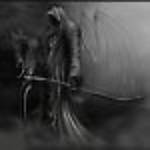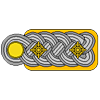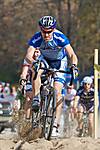Kevin, I've been air brushing with a Paasche H1 for more then 40 years. I'm on my 2nd gun only because the newer replacement parts don't fit the old gun. Go figure.
The H1 is an external mix, single action gun. There are no internal parts to be concerned with as far as flowing paint is concerned. As others have alluded to, you only need to be concerned with the standard #3 needle and cone, and the air nozzle.
Tests:
no needle or cone. make sure that the air button on top of the valve depresses all the way, and returns to full off. Set your compressor to 20 psi. make sure that the air flow is steady coming out of the nozzle, and that there is no air leaking around it. There is a rubber washer to seal it.
Examine your needle and cone. Hold the cone up to a strong light source, and you should see the light, without anything blocking it. If there is, it's dried paint. As Jess said, soak in Lacquer Thinner for a hour or so. Clean with a pipe cleaner. Blow dry. The needle is harder to check. dunk it in LC and watch the flow out of the front. It should be consistent time after time. If not, soak in LC, clean with a pipe cleaner followed by a Qtip.
Now examine the needle very carefully, no bends or a dull tip. Must be perfectly straight. If you crank it down to hard into the cone, you just make the hole larger, but that doesn't effect the flow of paint. That's a separate issue.
Test the flow by shooting some LC through the gun rather then water. Start with the cone turned down and slowly turn the cone till you start to get a spray pattern. Then continue to open the cone up till you get a larger pattern. The flow should be consistent with no spurting. If all is ok, the next step is air brushing paint.
Since you're using enamels, we'll test with that. Pick any color that will be easy to see on a piece of paper towel. I thin Model Master enamels 2 parts paint to 1 part thinner to start with, but for this 1st test, thin it 1:1. Use any Mineral Spirits for thinning, it doesn't matter. The important thing to remember is thinner 1st in the bowl, then the paint. Done the other way around, you will always get some unthinned paint forced into the needle and cone, and there is a clogging issue. Mix in the bowl. Set your compressor to 20 psi. Now start to paint the paper towel. Open up the cone just till the paint comes out. At 1st it will be a little blotchy. That's because there still isn't enough paint to air mixture. Open up the cone a little at a time till you get a smooth flow of paint.
Once you're able to get the paint to flow correctly, you need to work on a basic mixture that gives you a good flow rate, and decent coverage without running. For enamels I like a 3 parts paint to 2 parts thinner @ 18-20 psi.
When you're done painting. clean the needle, cone, and cup in Lacquer Thinner not Mineral Spirits. Use a pipe cleaner to get all the paint out of needle. Cleaning at the beginning takes time. As you get comfortable with the process it goes faster, and there are short cuts. I use my gun to paint small parts that takes less then a min to paint, cleanup is always just 5 min.
Joel










































